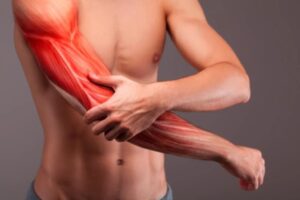Muscle Recovery
 Muscle Recovery
Muscle Recovery
Process of muscle recovery remains a fascinating area of study within the realms of physiology, sports science, and personal health. This complex phenomenon is not merely a singular event but a multifaceted sequence of biological processes. Understanding muscle recovery’s nuances offers profound insights into optimizing human performance and reducing injury risks.
Muscle recovery can be classified into immediate, short-term, and long-term recovery processes, each having its distinctive characteristics and underlying mechanisms. Immediate recovery deals with the replenishment of ATP (adenosine triphosphate) and creatine phosphate, which are the primary energy sources for muscle contraction. Short-term recovery involves the removal of metabolic byproducts like lactic acid and the restoration of muscle pH balance. Meanwhile, long-term recovery encompasses the repair and growth of muscle tissues following the microscopic damages incurred during vigorous physical activities.
Muscle rehabilitation is predominantly governed by the intricate interplay of mechanical, chemical, and hormonal signals. The process of hypertrophy, or muscle growth, is a response to the controlled damage caused by exercise, particularly resistance training. In this adaptive mechanism, satellite cells, which are a type of stem cell found in muscles, are activated to fuse with damaged muscle fibers, thereby facilitating the repair and growth of these tissues.
Nutrition plays a pivotal role in muscle rehabilitation. Macro and micronutrients contribute significantly to the repair and regeneration processes. Proteins and their constituent amino acids are the building blocks of muscle tissue. Carbohydrates replenish glycogen stores depleted during physical activity, while fats, have been shown to reduce muscle inflammation and soreness. In addition to macronutrients, various micronutrients and antioxidants contribute to optimal recovery.
Most importantly
Hydration is another critical factor in muscle rehabilitation. Water plays a key role in nutrient transport, thermoregulation, and joint lubrication. Dehydration can impede recovery by hindering these physiological processes and thereby compromising performance and increasing the risk of injuries.
Sleep is often hailed as one of the most powerful yet underestimated components of muscle rehabilitation. During sleep, particularly the deep stages, the body experiences an increase in growth hormone release, which facilitates tissue repair and muscle growth. Additionally, sleep deprivation can lead to elevated cortisol levels, a stress hormone that can inhibit muscle rehabilitation and growth.
Active recovery methods, such as low-intensity exercise, stretching, and mobility work, have been recognized for their benefits in enhancing circulation, reducing soreness, and accelerating the muscle healing process. Conversely, passive recovery methods, such as cold water immersion, hot baths, and massage therapy, can aid in reducing inflammation, muscle tightness, and perceived fatigue.
The concept of muscle recovery extends beyond the physiological dimensions and enters the psychological realm. Mental rest and stress management strategies, including mindfulness and meditation, have been observed to positively impact muscle rehabilitation times. Psychological stress can lead to prolonged cortisol elevation, delaying recovery and negatively affecting overall health.
Muscle recovery – multidimensional process influenced by an array of factors. An integrated approach that encompasses proper nutrition, hydration, adequate sleep, active and passive recovery techniques, along with stress management, can significantly enhance the efficiency of muscle rehabilitation. By delving into the complexities of this process, individuals can better understand how to optimize their recovery rates, improve physical performance, reduce injury risks. As research in this field continues to evolve, it is anticipated that novel insights and methodologies will further enhance our understanding and management of muscle recovery.
